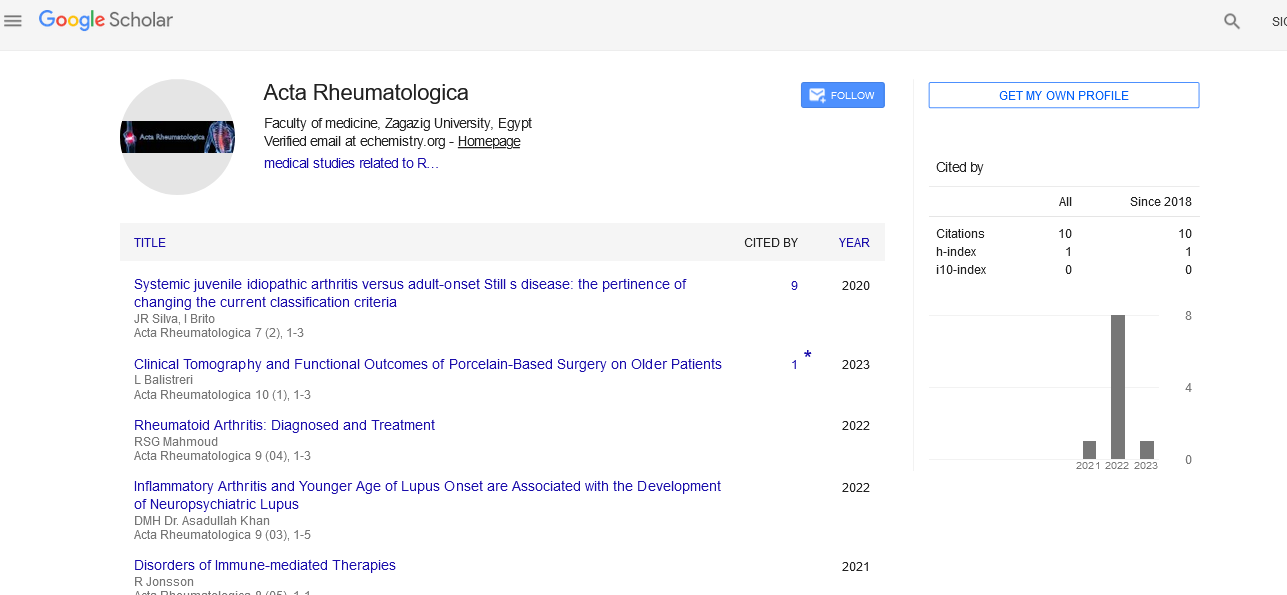Perspective - (2024) Volume 11, Issue 4
Navigating Juvenile Idiopathic Arthritis: Understanding, Coping, and Thriving
Anne Powell*
Department of Health Care, The University of Newcastle, Callaghan, Australia
*Correspondence:
Anne Powell, Department of Health Care, The University of Newcastle, Callaghan,
Australia,
Email:
Received: 08-Jul-2024, Manuscript No. IPAR-24-15052;
Editor assigned: 11-Jul-2024, Pre QC No. IPAR-24-15052 (PQ);
Reviewed: 25-Jul-2024, QC No. IPAR-24-15052;
Revised: 05-Aug-2024, Manuscript No. IPAR-24-15052 (R);
Published:
13-Aug-2024
Introduction
Juvenile Idiopathic Arthritis (JIA) is a chronic autoimmune
disorder that affects children and adolescents, posing unique
challenges due to its onset at an early age. This condition,
characterized by joint inflammation and stiffness, can
significantly impact a child's physical health, emotional well-being,
and overall quality of life. In this comprehensive article,
we explore the various aspects of JIA, including its types,
symptoms, diagnosis, treatment options, and the supportive
strategies essential for families navigating this journey.
Description
Understanding juvenile idiopathic arthritis
Juvenile Idiopathic Arthritis is the most common form of
arthritis in children under the age of 16, affecting approximately
1 in every 1,000 children worldwide. Formerly known as Juvenile
Rheumatoid Arthritis, JIA encompasses a group of chronic
inflammatory conditions that primarily affect the joints. Unlike
adult forms of arthritis, the exact cause of JIA remains unknown,
but it is believed to involve a combination of genetic
predisposition and environmental triggers that activate the
immune system to attack healthy tissues, particularly in the
joints.
Types of juvenile idiopathic arthritis
There are several subtypes of JIA, each with distinct
characteristics and patterns of joint involvement:
Oligoarticular JIA: This is the most common subtype, affecting
fewer than five joints in the first six months of disease onset. It
often involves the joints of the knees, ankles, and wrists.
Polyarticular JIA: Involves five or more joints within the first
six months of disease onset. It can be further divided into
rheumatoid factor-positive or negative categories based on the
presence of specific antibodies.
Systemic JIA: Characterized by arthritis accompanied by
systemic symptoms such as fever, rash, and inflammation of
internal organs. Systemic JIA can be particularly challenging due
to its unpredictable flare-ups and potential systemic
complications.
Enthesitis-related JIA: Involves inflammation where tendons
and ligaments attach to bones, commonly affecting the lower
limbs and spine. It may also be associated with conditions like
inflammatory bowel disease or psoriasis.
Psoriatic JIA: Presents with both arthritis and psoriasis, a skin
condition characterized by red, scaly patches.
Symptoms of juvenile idiopathic arthritis
The symptoms of JIA can vary widely depending on the
subtype and individual factors. Common symptoms include:
Joint pain: Often worse in the morning or after periods of
rest.
Joint stiffness: Difficulty with movement, especially after
waking up or sitting for extended periods.
Swelling: Inflammation and swelling around affected joints.
Fatigue: Feeling unusually tired or lacking energy, which can
affect daily activities and participation in school or social events.
Systemic symptoms: Fever, rash, loss of appetite, and
generalized malaise (feeling unwell).
In some cases, JIA can lead to complications such as growth
disturbances, eye inflammation (uveitis), and joint damage if left
untreated.
Diagnosis
Diagnosing JIA involves a thorough medical history, physical
examination, blood tests to rule out other conditions, imaging
studies (such as X-rays and MRI), and sometimes joint fluid
analysis. Early diagnosis is crucial to prevent joint damage and
improve long-term outcomes.
Treatment options
The goal of treatment for JIA is to relieve symptoms, prevent
joint damage, and improve quality of life. Treatment plans are
individualized based on the subtype of JIA and may include:
Medications: Nonsteroidal Anti-Inflammatory Drugs (NSAIDs),
Disease-Modifying Anti Rheumatic Drugs (DMARDs), biologic
therapies (such as TNF inhibitors), and corticosteroids to reduce
inflammation and manage symptoms.
Physical therapy: Exercises and stretches to improve joint
function, maintain range of motion, and strengthen muscles.
Occupational therapy: Techniques to help children and
adolescents manage daily activities and maintain independence
despite joint limitations.
Supportive therapies: Pain management strategies, assistive
devices (such as splints or braces), and lifestyle modifications to
promote overall well-being.
Regular follow-up visits with pediatric rheumatologists and
other healthcare providers are essential to monitor disease
activity, adjust treatment as needed, and address any emerging
concerns.
Living with juvenile idiopathic arthritis
Coping with JIA involves not only managing physical
symptoms but also addressing the emotional and social impact
on children and their families. Support from family, friends,
school personnel, and healthcare providers is crucial in fostering
resilience and promoting a positive outlook. Strategies for
coping and thriving with JIA include:
Education and advocacy: Empowering children and parents
with knowledge about JIA, treatment options, and selfmanagement
strategies.
Emotional support: Connecting with support groups,
counseling services, and peer networks to share experiences and
seek encouragement.
School and social participation: Collaborating with schools to
implement accommodations, such as flexible schedules or physical
accommodations, to support academic and social engagement.
Healthy lifestyle: Encouraging regular physical activity,
balanced nutrition, and adequate sleep to support overall health
and well-being.
Research and future directions
Advancements in research are continually improving our
understanding of JIA, leading to better diagnostic techniques,
more effective treatments, and potential strategies for disease
prevention. Clinical trials and collaborative efforts among
researchers, healthcare providers, and patient advocacy groups
are critical in advancing these goals.
Conclusion
Juvenile idiopathic arthritis is a complex chronic condition that
requires a comprehensive, multidisciplinary approach to
management. With early diagnosis, personalized treatment
plans, and ongoing support, children and adolescents with JIA
can lead fulfilling lives and achieve their full potential. By raising
awareness, promoting research, and fostering a supportive
community, we can continue to improve outcomes and
empower young individuals living with JIA and their families on
their journey towards health and wellness.
Citation: Powell A (2024) Navigating Juvenile Idiopathic Arthritis: Understanding, Coping, and Thriving. Acta Rheuma Vol:11 No:4





